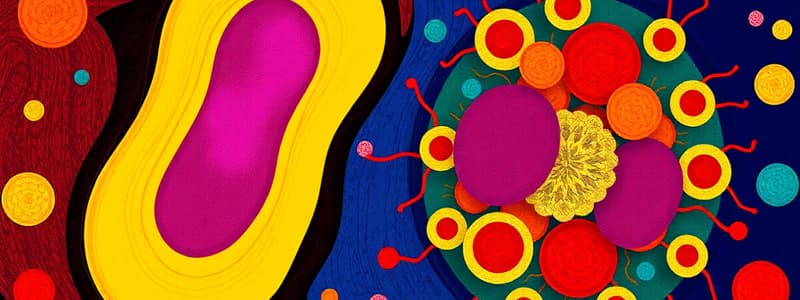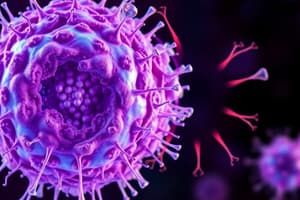Podcast
Questions and Answers
Which structure is characteristic of prokaryotic cells?
Which structure is characteristic of prokaryotic cells?
- Organelles like mitochondria
- Nuclear membrane
- Complex endoplasmic reticulum
- Mesosome (correct)
What distinguishes Gram positive bacteria from Gram negative bacteria?
What distinguishes Gram positive bacteria from Gram negative bacteria?
- Ability to take up gram stain (correct)
- Thickness of the glycocalyx
- Presence of a plasma membrane
- Presence of ribosomes
Which of the following statements is true regarding the cell envelope of prokaryotic cells?
Which of the following statements is true regarding the cell envelope of prokaryotic cells?
- It primarily provides energy for the cell.
- It contains three distinct layers. (correct)
- It is a loosely constructed structure.
- It consists of a single layer of plasma membrane.
What is the function of the plasma membrane in prokaryotic cells?
What is the function of the plasma membrane in prokaryotic cells?
Which structure determines the shape of a prokaryotic cell?
Which structure determines the shape of a prokaryotic cell?
What can the glycocalyx of bacteria vary in?
What can the glycocalyx of bacteria vary in?
What is the primary role of the outermost layer of the cell envelope in prokaryotes?
What is the primary role of the outermost layer of the cell envelope in prokaryotes?
Which statement accurately describes ribosomes in prokaryotic cells?
Which statement accurately describes ribosomes in prokaryotic cells?
What is the primary lipid component of the cell membrane?
What is the primary lipid component of the cell membrane?
Which statement correctly describes the arrangement of phospholipids in the cell membrane?
Which statement correctly describes the arrangement of phospholipids in the cell membrane?
What distinguishes integral proteins from peripheral proteins in cell membranes?
What distinguishes integral proteins from peripheral proteins in cell membranes?
What important model describes the structure of the cell membrane proposed by Singer and Nicolson?
What important model describes the structure of the cell membrane proposed by Singer and Nicolson?
What role does the fluid nature of the cell membrane play in cell functions?
What role does the fluid nature of the cell membrane play in cell functions?
Which component contributes to the stability and fluidity of the cell membrane?
Which component contributes to the stability and fluidity of the cell membrane?
What percentage of the cell membrane in human erythrocytes is made up of proteins?
What percentage of the cell membrane in human erythrocytes is made up of proteins?
What is a vital function of the plasma membrane according to its structure?
What is a vital function of the plasma membrane according to its structure?
Which organelles are included in the endomembrane system?
Which organelles are included in the endomembrane system?
What characterizes rough endoplasmic reticulum (RER)?
What characterizes rough endoplasmic reticulum (RER)?
What is the primary role of smooth endoplasmic reticulum (SER)?
What is the primary role of smooth endoplasmic reticulum (SER)?
Which statement is true regarding the endomembrane system?
Which statement is true regarding the endomembrane system?
Who first observed the structures later named Golgi bodies?
Who first observed the structures later named Golgi bodies?
What is a primary distinguishing feature of the endoplasmic reticulum?
What is a primary distinguishing feature of the endoplasmic reticulum?
Which of the following organelles is not part of the endomembrane system?
Which of the following organelles is not part of the endomembrane system?
What function do lysosomes primarily serve within the endomembrane system?
What function do lysosomes primarily serve within the endomembrane system?
What is the configuration of the centrioles within a centrosome?
What is the configuration of the centrioles within a centrosome?
What structure is formed by the central part of the proximal region of a centriole?
What structure is formed by the central part of the proximal region of a centriole?
What primarily composes the peripheral triplets of a centriole?
What primarily composes the peripheral triplets of a centriole?
What role do centrioles play during cell division in animal cells?
What role do centrioles play during cell division in animal cells?
Who first described the nucleus as a cell organelle?
Who first described the nucleus as a cell organelle?
What is the primary component of ribosomes?
What is the primary component of ribosomes?
Which of the following correctly distinguishes eukaryotic and prokaryotic ribosomes?
Which of the following correctly distinguishes eukaryotic and prokaryotic ribosomes?
What are the two subunit sizes of eukaryotic ribosomes known as 80S?
What are the two subunit sizes of eukaryotic ribosomes known as 80S?
What is the primary function of the cytoskeleton in a cell?
What is the primary function of the cytoskeleton in a cell?
Which of the following statements about ribosomes is incorrect?
Which of the following statements about ribosomes is incorrect?
Flashcards are hidden until you start studying
Study Notes
Prokaryote vs. Eukaryote Cells
- Prokaryotic cells are typically smaller (0.02-0.2 mm) than eukaryotic cells (10-20 mm)
- Eukaryotes have a nucleus, a cell membrane, and organelles, while prokaryotes do not have a nucleus, only have ribosomes as organelles, and have a unique mesosome
- Plasmids are used to monitor the transformation of bacteria with foreign DNA
Cell Envelope
- Most prokaryotic cells have a cell envelope consisting of a glycocalyx, cell wall, and plasma membrane
- The cell envelope acts as a protective unit
- Classification of bacteria is based on differences in their cell envelopes and staining properties: Gram-positive and Gram-negative
- Glycocalyx can be loose (slime layer) or thick and tough (capsule)
- The cell wall provides structural support and helps prevent the bacteria from bursting or collapsing
- The plasma membrane interacts with the external environment and is selectively permeable
Plasma Membrane
- The plasma membrane is composed of lipids and proteins
- The major lipids are phospholipids that are arranged in a bilayer with polar heads facing outward and hydrophobic tails facing inward
- Cholesterol is also present in the membrane
- Membrane proteins can be integral or peripheral
- Integral proteins are embedded in the membrane, while peripheral proteins are only on the surface
- The fluid mosaic model proposed by Singer and Nicolson in 1972 describes the structure of the cell membrane: the membrane is fluid and proteins can move laterally within it
- The fluidity of the membrane is essential for several functions such as growth, intercellular junctions, secretion, endocytosis, and cell division
Endomembrane System
- The endomembrane system includes: ER, Golgi complex, lysosomes, and vacuoles
- Mitochondria, chloroplast, and peroxisomes are not part of the endomembrane system
- The endomembrane system functions are coordinated
Endoplasmic Reticulum (ER)
- ER is a network of tiny tubular structures scattered in the cytoplasm
- It divides the intracellular space into luminal (inside ER) and extraluminal (cytoplasm) compartments
- RER has ribosomes attached to its outer surface
- SER lacks ribosomes
- RER is involved in protein synthesis and secretion
- SER is the site of lipid synthesis, including steroidal hormones in animal cells
Golgi Apparatus
- Golgi bodies are densely stained reticular structures near the nucleus
- They are involved in the processing and packaging of proteins and lipids
- They consist of flattened membrane-bound sacs called cisternae
Mitochondria
- Mitochondria are double membrane-bound organelles
- They are the sites of cellular respiration and ATP production
- The inner membrane of mitochondria is folded into cristae, which increases surface area for ATP production
Lysosomes
- Lysosomes are membrane-bound vesicles that contain hydrolytic enzymes
- They are involved in the degradation of cellular waste materials, foreign substances, and worn-out organelles
- Lysosomes have a role in autophagy (self-eating) and apoptosis (programmed cell death)
Vacuoles
- Vacuoles are large membrane-bound sacs that occupy a significant portion of the plant cell volume
- They are involved in storage of water, nutrients, and waste products
- Vacuoles also help maintain turgor pressure in plant cells
Chloroplasts
- Chloroplasts are double membrane-bound organelles found in plant cells
- They contain chlorophyll pigments and are the sites of photosynthesis
- They have a third membrane system called thylakoids, which are stacked into grana
- Chloroplasts have their own DNA (circular) and ribosomes (70S)
Ribosomes
- Ribosomes are granular structures composed of RNA and proteins
- They are not surrounded by a membrane
- Eukaryotic ribosomes are 80S, and prokaryotic ribosomes are 70S
- Each ribosome has two subunits: a larger and a smaller subunit
- Ribosomes are the sites of protein synthesis
Cytoskeleton
- The cytoskeleton is a network of filamentous proteinaceous structures present in the cytoplasm
- It includes microtubules, microfilaments, and intermediate filaments
- It provides mechanical support, enables motility, and maintains cell shape
Centrosome and Centrioles
- The centrosome is an organelle that usually contains two cylindrical structures called centrioles
- Centrioles are made up of nine peripheral fibrils of tubulin protein arranged in triplets
- The centrioles form the basal bodies of cilia and flagella, and spindle fibers during cell division in animal cells
Nucleus
- The nucleus was first described by Robert Brown in 1831
- The nuclear material stained by basic dyes was named chromatin by Flemming
- The interphase nucleus contains chromatin, nuclear matrix, and one or more nucleoli
- The nucleus is the control center of the cell, containing the cell's genetic material (DNA)
- The nucleus is involved in the regulation of gene expression and cell division
Studying That Suits You
Use AI to generate personalized quizzes and flashcards to suit your learning preferences.




